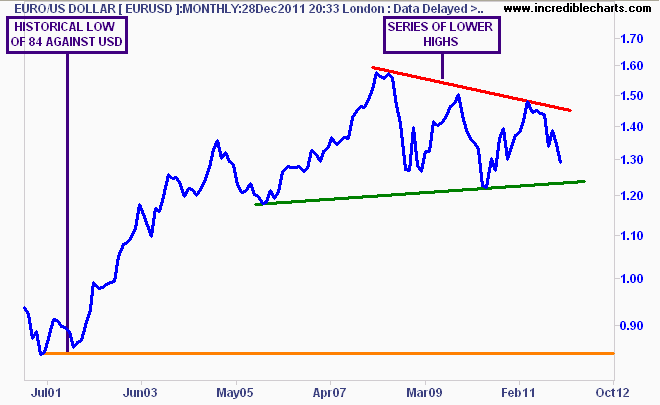Today’s chart is a monthly price chart of the Euro currency since it was adopted for circulation (after conversion from the former sovereign currencies) against the other monolithic currency, the US dollar.
The Euro is the world’s largest currency union between nation-States and as such, arguably the last gold-standard currency as opposed to the standard monetary system which is fiat currency based. The ongoing Euro debt crisis and latest measures by the European Central Bank (ECB) may be putting that thesis to bed, although fiscal integration would ensure a full fiat standard.
Anyway, on to the chart, which I’ve made as simple as possible to highlight the large moves in the currency and place the current turmoil in context:

First, the Euro has advanced from a low of about 84 against the USD to almost 1.60, reached at the peak of the “risk-on” bubble before the Global Financial Crisis (GFC) of 2008. Since then, the currency has oscillated, rising when “risk on”, or “US dollar off” and falling when “risk off”, i.e when other un-USD dollar assets are also sold off.
This is the binary nature of modern financialised markets.
Any waves of monetary easing are evident through the price action. But what do the tea leaves say now, since the ECB appears to be conducting its own form of quantitative easing?
A series of lower highs since the GFC in 2008, that is, the failure of the market to bid the Euro any higher on subsequent attempts through monetary easing (QE1 March to November 2009, QE2 August 2010 to April 2011) is clearly evident.
Now that risk has been turned off, the Euro is heading back down to its “support” area just above 1.20 against the USD, an area touched many times in the past and assumed to be a level that monetary authorities do not want breached.
Be wary of predicting macro moves based on technical analysis, although short and medium term strategies can be formed around them, the long term is still determined by the macroeconomic/geopolitical fundamentals.
